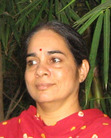Harini Gopalswami Srinivasan's Blog: Read, Write and Left, page 2
December 4, 2013
Solar so good!
Our farm is running completely on solar -- the Grundfos helical pump works like a dream on direct solar, and we have an inverter for domestic power. SELCO are our heroes and angels! We celebrated Deepavali and Karthigai -- the two festivals of lights -- with these beautiful solar garden lights given us by a thoughtful nephew.
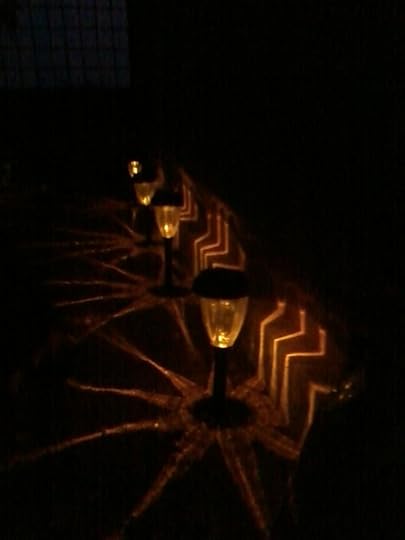
Camping in our almost finished house has been uncomfortable fun. It has so many holes that we are the local mice's zoo. They queue up to stand on our toes and watch us sleep. This cutie pie was the most sensible and preferred to look for crumbs in the kitchen sink.

We haven't grown much on the land this year, apart from planting a rather haphazard fruit orchard -- about 40 mango, chikoo and guava trees. But we hope to be tilling our fields (such as they are) in earnest when the next monsoon arrives. This Pongal, we're not going to have much to harvest; but thanks to our harvest of sunlight, we are completely self-sufficient for water and power, and proud to be off the grid.


Camping in our almost finished house has been uncomfortable fun. It has so many holes that we are the local mice's zoo. They queue up to stand on our toes and watch us sleep. This cutie pie was the most sensible and preferred to look for crumbs in the kitchen sink.

We haven't grown much on the land this year, apart from planting a rather haphazard fruit orchard -- about 40 mango, chikoo and guava trees. But we hope to be tilling our fields (such as they are) in earnest when the next monsoon arrives. This Pongal, we're not going to have much to harvest; but thanks to our harvest of sunlight, we are completely self-sufficient for water and power, and proud to be off the grid.

Published on December 04, 2013 23:41
November 26, 2013
Books and covers
Alan Bradley is my new favourite author. It's amazing how he simply tosses together all my favourite ingredients -- old English country house, the 50s, ghastly-funny-clever kid, awful-but-somehow-redeemed sisters, chemistry lab, books and more books, woolly vicar, a boy's school from the 20s complete with quad, gowns and mortar boards, dark woods and crumbling farms, a travelling puppet show, a WW II relic father and dark old mysteries; stirs them just so and cooks them perfectly! Judging by the reviews of his work, these are a lot of other people's favourite things too.
What surprises me are his covers. If I hadn't read all the rave reviews, but just come across the books in a shop, I doubt if I would have picked them up. They hardly convey the idea of the cozy British mystery. On the other hand, I suppose they do convey the workings of the mind of Flavia de Luce, strange child that she is.
The appeal of a cover seems to be unpredictable. For one thing, a reader's idea of a book may or may not correspond to the writer's -- the Alan Bradley books being a case in point. On top of this, the reader's and the writer's tastes change over time. For instance, Penguin's jazz themed covers for the 2000 edition of Wodehouse did not appeal to me when they first came out, but now I think they absolutely capture the soul of Wodehouse. The third angle, and a completely different one, is that of the publisher's marketing team. My publishers and I did not see eye to eye on the covers of Vanuvati and Gind.
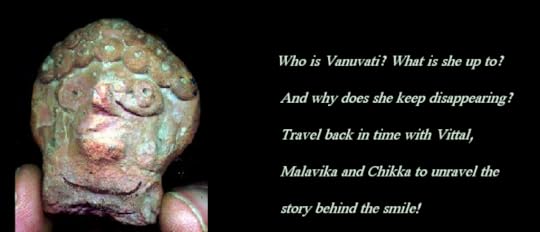 This was my idea of Vanuvati, but it didn't appeal to the Tulika editors. The cover they chose was nice too, but less dramatic.
This was my idea of Vanuvati, but it didn't appeal to the Tulika editors. The cover they chose was nice too, but less dramatic.
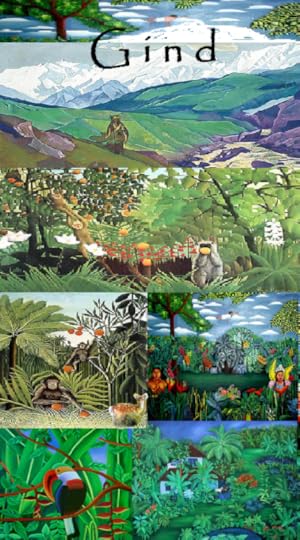 For Gind I wanted a fantasy cover that had elements of the paintings of Murali Nagapuzha, Nicholas Roerich and Henri Rousseau, all of whose work I simply adore. I put together a concept collage of paintings of these artists, but somehow nothing came of it. But it was still a wonderful and very rewarding exercise to look for, and find, visual images from the minds of various artists that corresponded to the word pictures that I was attempting to paint. I think readers who enjoyed Gind will be interested to see the concept collage, which represents the world of Gind as I imagine it.
For Gind I wanted a fantasy cover that had elements of the paintings of Murali Nagapuzha, Nicholas Roerich and Henri Rousseau, all of whose work I simply adore. I put together a concept collage of paintings of these artists, but somehow nothing came of it. But it was still a wonderful and very rewarding exercise to look for, and find, visual images from the minds of various artists that corresponded to the word pictures that I was attempting to paint. I think readers who enjoyed Gind will be interested to see the concept collage, which represents the world of Gind as I imagine it.
Credits: Top picture is from one of Murali Nagapuzha's paintings in his Childhood series; second is Roerich's En-no-Gyoja, the Friend of Travellers; third is Henri Rousseau's Exotic Landscape; fourth row left is Rousseau's Two Monkeys in the Jungle; fourth right is Nagapuzha; and fifth row right and left are Nagapuzha again, all of these being from his 'Nature' and 'My Native' series.
What surprises me are his covers. If I hadn't read all the rave reviews, but just come across the books in a shop, I doubt if I would have picked them up. They hardly convey the idea of the cozy British mystery. On the other hand, I suppose they do convey the workings of the mind of Flavia de Luce, strange child that she is.
The appeal of a cover seems to be unpredictable. For one thing, a reader's idea of a book may or may not correspond to the writer's -- the Alan Bradley books being a case in point. On top of this, the reader's and the writer's tastes change over time. For instance, Penguin's jazz themed covers for the 2000 edition of Wodehouse did not appeal to me when they first came out, but now I think they absolutely capture the soul of Wodehouse. The third angle, and a completely different one, is that of the publisher's marketing team. My publishers and I did not see eye to eye on the covers of Vanuvati and Gind.
 This was my idea of Vanuvati, but it didn't appeal to the Tulika editors. The cover they chose was nice too, but less dramatic.
This was my idea of Vanuvati, but it didn't appeal to the Tulika editors. The cover they chose was nice too, but less dramatic. For Gind I wanted a fantasy cover that had elements of the paintings of Murali Nagapuzha, Nicholas Roerich and Henri Rousseau, all of whose work I simply adore. I put together a concept collage of paintings of these artists, but somehow nothing came of it. But it was still a wonderful and very rewarding exercise to look for, and find, visual images from the minds of various artists that corresponded to the word pictures that I was attempting to paint. I think readers who enjoyed Gind will be interested to see the concept collage, which represents the world of Gind as I imagine it.
For Gind I wanted a fantasy cover that had elements of the paintings of Murali Nagapuzha, Nicholas Roerich and Henri Rousseau, all of whose work I simply adore. I put together a concept collage of paintings of these artists, but somehow nothing came of it. But it was still a wonderful and very rewarding exercise to look for, and find, visual images from the minds of various artists that corresponded to the word pictures that I was attempting to paint. I think readers who enjoyed Gind will be interested to see the concept collage, which represents the world of Gind as I imagine it. Credits: Top picture is from one of Murali Nagapuzha's paintings in his Childhood series; second is Roerich's En-no-Gyoja, the Friend of Travellers; third is Henri Rousseau's Exotic Landscape; fourth row left is Rousseau's Two Monkeys in the Jungle; fourth right is Nagapuzha; and fifth row right and left are Nagapuzha again, all of these being from his 'Nature' and 'My Native' series.
Published on November 26, 2013 01:22
September 17, 2013
Bala Kanda launch
Exciting news! Amar Chitra Katha is planning to launch Bala Kanda, the first volume of the Ramayana, during Navaratri, which begins in early October. Meanwhile, there will be a cover launch at the Comic Con in Hyderabad on September 22. Looking at the Comic Con schedule, I'm all agog. It's a long time since I outgrew comics (as a staple diet, that is), but the remembered joy is still with me and I'm looking forward to seeing what goes on when comic fans get together.
Being the first of the seven books of the Ramayana, the Bala Kanda sets the tone for the entire work. Initially, I was flabbergasted to see the sophisticated storytelling techniques used by Valmiki. For instance, the narrative is actually a story within a story within a story! It is also very exciting to realize that these events are being related by a rishi who lived in those ancient times. No one really knows how ancient, but the Mahabharata itself is over 5000 years old according to Aryabhatta; and the Ramayana was already ancient at that time. It has been a wonderful learning experience for me to read and try to convey simply the thoughts and deeds of Valmiki’s immortal characters. Equally fascinating is the research into various aspects of the Vedic civilization: the comics include fact pages on the Vedic gods, rituals, social structure, education, food, weapons, etc.
In a comic, the illustrations are as important as the text, if not more so. It is part of the scriptwriter’s job to visualize each scene and provide cues for the artist. I have tried to faithfully convey Valmiki’s descriptions to the artist. I remember the Editor, Reena Puri, once telling me that Zoheb was trying very hard to make Dasharatha’s queens “smile like lotuses”! I will post some of the illustrations once I get permission from ACK -- look out for them! Meanwhile, here's a picture of the artist, smiling a bit like a lotus himself! It's been a thrilling experience for me to see the world of the Ramayana spring to glorious life at the skilful hands of Zoheb, Prakash, Adarsh, Silambarasan and Sivajith.
It's been a thrilling experience for me to see the world of the Ramayana spring to glorious life at the skilful hands of Zoheb, Prakash, Adarsh, Silambarasan and Sivajith.
I've also been very lucky in finding an expert to vet the text and make sure there are no bloomers: Mangala Kumari, a Sanskrit teacher who lectures on the Ramayana. She has become a good friend over the last couple of years, as has Reena Puri -- an unlooked for bonus when this opportunity knocked at my door.
Being the first of the seven books of the Ramayana, the Bala Kanda sets the tone for the entire work. Initially, I was flabbergasted to see the sophisticated storytelling techniques used by Valmiki. For instance, the narrative is actually a story within a story within a story! It is also very exciting to realize that these events are being related by a rishi who lived in those ancient times. No one really knows how ancient, but the Mahabharata itself is over 5000 years old according to Aryabhatta; and the Ramayana was already ancient at that time. It has been a wonderful learning experience for me to read and try to convey simply the thoughts and deeds of Valmiki’s immortal characters. Equally fascinating is the research into various aspects of the Vedic civilization: the comics include fact pages on the Vedic gods, rituals, social structure, education, food, weapons, etc.
In a comic, the illustrations are as important as the text, if not more so. It is part of the scriptwriter’s job to visualize each scene and provide cues for the artist. I have tried to faithfully convey Valmiki’s descriptions to the artist. I remember the Editor, Reena Puri, once telling me that Zoheb was trying very hard to make Dasharatha’s queens “smile like lotuses”! I will post some of the illustrations once I get permission from ACK -- look out for them! Meanwhile, here's a picture of the artist, smiling a bit like a lotus himself!
 It's been a thrilling experience for me to see the world of the Ramayana spring to glorious life at the skilful hands of Zoheb, Prakash, Adarsh, Silambarasan and Sivajith.
It's been a thrilling experience for me to see the world of the Ramayana spring to glorious life at the skilful hands of Zoheb, Prakash, Adarsh, Silambarasan and Sivajith. I've also been very lucky in finding an expert to vet the text and make sure there are no bloomers: Mangala Kumari, a Sanskrit teacher who lectures on the Ramayana. She has become a good friend over the last couple of years, as has Reena Puri -- an unlooked for bonus when this opportunity knocked at my door.
Published on September 17, 2013 20:38
August 24, 2013
Chronicles of ordinary, long-ago lives
My mother is obsessed with Jodha Akbar (the Hindi television serial that is currently being aired, not the Aishwarya Rai movie). She watches two episodes a day on TV, reruns and recaps on Youtube and Desi Tashan (some, like the wedding episode, she has seen half a dozen times and continues to see), and also reads the written episode available on various sites, lest she should have missed something. Like the makers of the serial, she believes that, if only enough people watch it, Hindu-Muslim unity will inevitably follow. It's a good thought, but it seems to me a bit like saving Tinkerbelle by clapping to show you believe in fairies. However, this post is not about Jodha Akbar but about history.
I hated history in school, which is strange because I have always loved stories. It is only recently that I realized the reason for this aversion. It is because we were never taught anything about the ordinary lives of ordinary people of the past. It was always all about kings and queens, prime ministers and other figures of power, about battles and accessions and defeats and duplicity. Aaaargh! The closest we came to the ordinary was learning about kings who "dug wells and planted trees". This indicated a good king, but also meant there were no dates to memorize. So they not only earned the thanks of their subjects, but also the undreamt of gratitude of school children millenia later.
So strong has been my dislike of royal histories that I have sheered off even historical novels like those of Indu Sunderasan and William Dalrymple, which everyone around me is reading avidly. On the other hand, there are a number of historical novels I absolutely love. These are about the imagined lives of ordinary people. Their impact does not extend over the kingdom or the world. The world does not ring with their names. They may be extraordinary by virtue of their thoughts, words or deeds, never by their position. They are colourful, but they do not glitter. They are people like Deeti and Kalua in Amitav Ghosh's Ibis trilogy (where is Book 3, Amitav Ghosh?!), Laura Ingalls Wilder in her books, all the real people I never heard of before in "My Experiments with Truth", Mahadev Desai in the play "Mahadevbhai" (I loved Jaimini Pathak in the lead role), the people in V S Naipaul's "A Writer's People", Old Filth in Jane Gardam's "Old Filth", Quentin Durward and Ivanhoe... I loved the idea behind T V Padma's "The Forbidden Temple", though it didn't quite carry me away, maybe because the stories are too short for an adult reader to get really involved. (In the interests of modesty, I will refrain from mentioning my own books, which I believe fulfill the necessary conditions.)
I have learnt so much and lived so much through these books. Not only facts, but feelings. Not just history, but humanity. They appeal to the heart as well as the head; they uplift the spirit.
I'd love to read more books like these, where the history is carefully researched but it is the lives of ordinary people that are centre stage. What are your favourite books/ characters in this genre? (What is this genre, anyway? Is it historical fiction? Historical fantasy?) Please write in and add to my list. And would someone please tell the syllabus makers that this is one way to get kids to enjoy history?
I hated history in school, which is strange because I have always loved stories. It is only recently that I realized the reason for this aversion. It is because we were never taught anything about the ordinary lives of ordinary people of the past. It was always all about kings and queens, prime ministers and other figures of power, about battles and accessions and defeats and duplicity. Aaaargh! The closest we came to the ordinary was learning about kings who "dug wells and planted trees". This indicated a good king, but also meant there were no dates to memorize. So they not only earned the thanks of their subjects, but also the undreamt of gratitude of school children millenia later.
So strong has been my dislike of royal histories that I have sheered off even historical novels like those of Indu Sunderasan and William Dalrymple, which everyone around me is reading avidly. On the other hand, there are a number of historical novels I absolutely love. These are about the imagined lives of ordinary people. Their impact does not extend over the kingdom or the world. The world does not ring with their names. They may be extraordinary by virtue of their thoughts, words or deeds, never by their position. They are colourful, but they do not glitter. They are people like Deeti and Kalua in Amitav Ghosh's Ibis trilogy (where is Book 3, Amitav Ghosh?!), Laura Ingalls Wilder in her books, all the real people I never heard of before in "My Experiments with Truth", Mahadev Desai in the play "Mahadevbhai" (I loved Jaimini Pathak in the lead role), the people in V S Naipaul's "A Writer's People", Old Filth in Jane Gardam's "Old Filth", Quentin Durward and Ivanhoe... I loved the idea behind T V Padma's "The Forbidden Temple", though it didn't quite carry me away, maybe because the stories are too short for an adult reader to get really involved. (In the interests of modesty, I will refrain from mentioning my own books, which I believe fulfill the necessary conditions.)
I have learnt so much and lived so much through these books. Not only facts, but feelings. Not just history, but humanity. They appeal to the heart as well as the head; they uplift the spirit.
I'd love to read more books like these, where the history is carefully researched but it is the lives of ordinary people that are centre stage. What are your favourite books/ characters in this genre? (What is this genre, anyway? Is it historical fiction? Historical fantasy?) Please write in and add to my list. And would someone please tell the syllabus makers that this is one way to get kids to enjoy history?
Published on August 24, 2013 22:40
August 13, 2013
Rama, Krishna and Kalki: some thoughts on the Ramayana
Rama has always been a controversial figure. People either adore him or deplore his treatment of Sita. Feminists through the ages have subtly subverted the epic, including through songs centred around the experiences of Sita and her champion, Shanta (Rama's sister). Even his staunchest devotees have reservations about some of his actions, like the killing of Vali. This is my take on Rama.
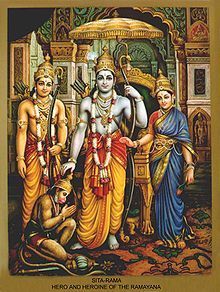
Scholars have pointed out that the evolution of the Vishnu avataras from matsya (fish) through Narasimha (man-lion) to Rama and Krishna (human) closely parallels the Darwinian course of evolution. Rama is generally held to be the embodiment of dharma, or duty, and Krishna the embodiment of love. In Krishna we see every form of love from mother love to romantic love to loving friendship to bhakti.
If Krishna is one step up from Rama, it follows that love is a step up from duty. But just as an amoeba cannot turn into a human without passing through every stage of evolution, one cannot get to love without passing through dharma. So if Rama appears to sternly adhere to dharma without regard to the feelings of his beloved wife, it is because he must. Even though he hurts himself too in the process, the priority of dharma cannot be overridden. He is a necessary step in the evolution of humankind. A possible English equivalent to Rama's attitude is Richard Lovelace's famous line, "I could not love thee, dear, so much, loved I not honour more." Perhaps this is the principle underlying all chivalry.
I'm not really sure I subscribe to the avatara story. What I think is likely is that Rama and Krishna were real historical figures who were deified in the usual way that ancient peoples deified their kings; and that they had some really special qualities that made them more godlike than other kings. The avatara story is possibly a grand- or meta-metaphor to describe the evolution of life on earth.
This makes me wonder: what is the overriding quality of Kalki, the avatara-to-come? Is it something we know but don't give importance to? Or something new that we've never dreamt of? Like the myriad colours that a bee may see but we can't?

Scholars have pointed out that the evolution of the Vishnu avataras from matsya (fish) through Narasimha (man-lion) to Rama and Krishna (human) closely parallels the Darwinian course of evolution. Rama is generally held to be the embodiment of dharma, or duty, and Krishna the embodiment of love. In Krishna we see every form of love from mother love to romantic love to loving friendship to bhakti.
If Krishna is one step up from Rama, it follows that love is a step up from duty. But just as an amoeba cannot turn into a human without passing through every stage of evolution, one cannot get to love without passing through dharma. So if Rama appears to sternly adhere to dharma without regard to the feelings of his beloved wife, it is because he must. Even though he hurts himself too in the process, the priority of dharma cannot be overridden. He is a necessary step in the evolution of humankind. A possible English equivalent to Rama's attitude is Richard Lovelace's famous line, "I could not love thee, dear, so much, loved I not honour more." Perhaps this is the principle underlying all chivalry.
I'm not really sure I subscribe to the avatara story. What I think is likely is that Rama and Krishna were real historical figures who were deified in the usual way that ancient peoples deified their kings; and that they had some really special qualities that made them more godlike than other kings. The avatara story is possibly a grand- or meta-metaphor to describe the evolution of life on earth.
This makes me wonder: what is the overriding quality of Kalki, the avatara-to-come? Is it something we know but don't give importance to? Or something new that we've never dreamt of? Like the myriad colours that a bee may see but we can't?
Published on August 13, 2013 22:55
July 25, 2013
Writer's Help... Not!
I've been neglecting my work, including this blog, thanks to a new addition to the family -- Lal Mohan the home wrecker. One of these days, I'll write a post about her and the exciting story of her rescue. Actually, I think there's a terrific picture book there, but it can't be written until the heroine has calmed down a bit. Meanwhile, here she is. Yes, she eats rocks for breakfast. Among other things.

And chasing it down with a drink -- with Topshe at the farm:
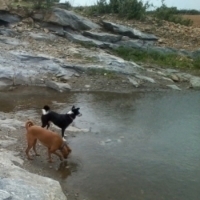

And chasing it down with a drink -- with Topshe at the farm:

Published on July 25, 2013 20:32
October 7, 2012
Feisty/ fervent/ femme fatale/ frivolous
This is a classification of fictional heroines (I do like classifying things). The world got tired of the fervent type a few decades ago, and the femme fatale has been almost done to death. Methinks the feisty heroine is now getting ubiquitous. I have just finished about my tenth book running with a feisty heroine. I'm getting pretty worn out by all the indignation. My vote, as a reader and also possibly as a writer, is just now for the frivolous. Because it seems to me that's the closest to normal and most comfortable to be with. Hey, the frivolous can have adventures too!
Published on October 07, 2012 05:32
August 6, 2012
Who do you write for?
Mothers play many roles, but it wasn’t until recently that it struck me -- writing is one of them. My children, it turns out, have been my target audience all the time.
My first book was a story I used to tell them as toddlers. The second was set in an archaeological dig that we visited, because they (and I) found it fascinating. (Unfortunately, they had outgrown the book by the time it was finished and I had to endure a lot of criticism of the morons that I wrote about.) Gind, the third book, was a favourite with the whole family from the start, and we had rollicking times plotting, writing and hijacking it. All this community writing rather went to my head and I bunged in whatever pleased us – gods, celestial beings, Tamil words, snow, rishis, islands, rabbits, strange foods, mountains, mythical animals, you name it.
Book four, a murder mystery, which lies languishing in the hard disk of my computer, was an aberration. It wasn’t for children; it was written to amuse my husband who had broken his leg and was feeling frustrated. We spent weeks arguing about the characters, the setting, the plot and everything else. He wrote 6 pages, killed off all the characters and called it quits, quite pleased with the day’s work. But my kanjoos soul wouldn’t let me give up after so much thought had gone into the book, so I muddled my way through it. The girls, now grown up, approved of it. My editor liked it too, but apparently it didn’t look like the sort of book that would sell. So there it lies. Not resting in peace, though – every once in a while it is exhumed and post-mortemed.
Now I am back to my first love – children’s books – but I no longer have a readymade audience. The question has got to be answered – who am I writing for? This post was to help me figure it out. Still figuring…
So, who do you you write for? I’d love to hear.
My first book was a story I used to tell them as toddlers. The second was set in an archaeological dig that we visited, because they (and I) found it fascinating. (Unfortunately, they had outgrown the book by the time it was finished and I had to endure a lot of criticism of the morons that I wrote about.) Gind, the third book, was a favourite with the whole family from the start, and we had rollicking times plotting, writing and hijacking it. All this community writing rather went to my head and I bunged in whatever pleased us – gods, celestial beings, Tamil words, snow, rishis, islands, rabbits, strange foods, mountains, mythical animals, you name it.
Book four, a murder mystery, which lies languishing in the hard disk of my computer, was an aberration. It wasn’t for children; it was written to amuse my husband who had broken his leg and was feeling frustrated. We spent weeks arguing about the characters, the setting, the plot and everything else. He wrote 6 pages, killed off all the characters and called it quits, quite pleased with the day’s work. But my kanjoos soul wouldn’t let me give up after so much thought had gone into the book, so I muddled my way through it. The girls, now grown up, approved of it. My editor liked it too, but apparently it didn’t look like the sort of book that would sell. So there it lies. Not resting in peace, though – every once in a while it is exhumed and post-mortemed.
Now I am back to my first love – children’s books – but I no longer have a readymade audience. The question has got to be answered – who am I writing for? This post was to help me figure it out. Still figuring…
So, who do you you write for? I’d love to hear.
Published on August 06, 2012 09:19
April 6, 2012
BBC -- Bad Biography Corporation OR Enid and the Blighters
What's with the BBC and bad biographies? I've always been a fan of their television dramas. Absolutely LOVE their Jeeves and Wooster series, Doctor Who, the Forsyte Saga, Barchester Towers, the Jennifer Ehle Pride and Prejudice, the Kate Beckinsale Emma, the David Suchet Poirot series and the ongoing Sherlock Holmes series (brilliant!), and lots of other stuff. But their biographies are quite another story. Two I saw recently, "Enid" and "Pandaemonium", are definitely actionable.
Picture this: a father comes home to his wife and children to find that the wife is having an affair with another man. His daughters, though, are happy to see him, and the younger one asks, "Do you want to come see our rabbit? We did have two, but Mummy and Uncle Kenneth ate the other one."
And who is this horrid Mummy? None other than Enid Blyton, probably the best-loved children's author in India, and the one who got a generation of children reading, as Rowling is doing for the children of today. Okay, so she has her faults. Rereading her as an adult, one can see them all quite clearly; the overtones of sexism and racism, the self-righteousness... But for sheer delight, excitement and fun, there are very few writers to touch her. Given this, the BBC biopic is completely one-sided, unfair and objectionable. Didn't she have any redeeming qualities? Did her millions of fans have to be represented quite so ironically? On reading up on her afterwards, I found that, of her two daughters, it was the younger, Imogen, who was most scarred by Blyton's selfish and unmaternal behaviour, and who publicly denounced her; while Gillian, the elder, refused to endorse her condemnation of their mother. Whatever the truth was, I think the BBC should have taken a neutral stance. If they were hoping to be funny, they failed quite miserably. I confess, though, that rabbit incident did surprise a laugh out of me.
In "Pandaemonium", again, the BBC has chosen to adopt the modern, popular view of Wordsworth as a pedestrian poet with no talent or vision, using him as a foil to Coleridge, the genius. Well, one cannot be entirely bland -- it doesn't make for good copy or good movies. But did they have to paint Wordsworth as a complete villain, to the extent that he tries to suppress and destroy Coleridge's work? Is there any truth to this story? The characters in this movie are intrinsically fascinating, and the drama is enlivened by some really hilarious lines ('I wandered lonely as a cow'). The BBC is good. It really does not have to stoop to sensationalism to sell its stuff. A movie about real historical characters will always be viewed in some sense as a documentary, and should therefore not venture too far from fact. Does it make it all right to slander someone just because they're dead? I wish Enid and Wordsworth could rise up from the grave and sue the blighters.
Picture this: a father comes home to his wife and children to find that the wife is having an affair with another man. His daughters, though, are happy to see him, and the younger one asks, "Do you want to come see our rabbit? We did have two, but Mummy and Uncle Kenneth ate the other one."
And who is this horrid Mummy? None other than Enid Blyton, probably the best-loved children's author in India, and the one who got a generation of children reading, as Rowling is doing for the children of today. Okay, so she has her faults. Rereading her as an adult, one can see them all quite clearly; the overtones of sexism and racism, the self-righteousness... But for sheer delight, excitement and fun, there are very few writers to touch her. Given this, the BBC biopic is completely one-sided, unfair and objectionable. Didn't she have any redeeming qualities? Did her millions of fans have to be represented quite so ironically? On reading up on her afterwards, I found that, of her two daughters, it was the younger, Imogen, who was most scarred by Blyton's selfish and unmaternal behaviour, and who publicly denounced her; while Gillian, the elder, refused to endorse her condemnation of their mother. Whatever the truth was, I think the BBC should have taken a neutral stance. If they were hoping to be funny, they failed quite miserably. I confess, though, that rabbit incident did surprise a laugh out of me.
In "Pandaemonium", again, the BBC has chosen to adopt the modern, popular view of Wordsworth as a pedestrian poet with no talent or vision, using him as a foil to Coleridge, the genius. Well, one cannot be entirely bland -- it doesn't make for good copy or good movies. But did they have to paint Wordsworth as a complete villain, to the extent that he tries to suppress and destroy Coleridge's work? Is there any truth to this story? The characters in this movie are intrinsically fascinating, and the drama is enlivened by some really hilarious lines ('I wandered lonely as a cow'). The BBC is good. It really does not have to stoop to sensationalism to sell its stuff. A movie about real historical characters will always be viewed in some sense as a documentary, and should therefore not venture too far from fact. Does it make it all right to slander someone just because they're dead? I wish Enid and Wordsworth could rise up from the grave and sue the blighters.
Published on April 06, 2012 03:23
Kitten love
 Four tiny kittens arrived at our house two weeks ago. They were discovered in a ditch, presumably dumped there by someone who didn't want to give them house room. Their eyes had just opened, and they had to be bottle fed. I didn't even know they had special feeding bottles for puppies and kittens, but the kind vet who delivered them to our house to be fostered until homes were found for them brought all the supplies we'd need. A tin of puppy formula, a feeding bottle with its own cute bottle brush, some Cerelac and a bottle of a digestive stimulant like gripe water, specially formulated for small animals.
Four tiny kittens arrived at our house two weeks ago. They were discovered in a ditch, presumably dumped there by someone who didn't want to give them house room. Their eyes had just opened, and they had to be bottle fed. I didn't even know they had special feeding bottles for puppies and kittens, but the kind vet who delivered them to our house to be fostered until homes were found for them brought all the supplies we'd need. A tin of puppy formula, a feeding bottle with its own cute bottle brush, some Cerelac and a bottle of a digestive stimulant like gripe water, specially formulated for small animals. I'm glad I'm not a mother cat. The critters needed feeding every 2-3 hours (fortunately this has changed to 4-5 hours over the fortnight they've been here now), and then cleaned up, played with and cuddled. The last two are of course the best! But I guess the mother cat wouldn't be wanting to go to a writer's meet, entertain friends or write a blog post. Or would it?
The immediate problem was what to do with Topshe, who thinks cats are just made to be chased. But we've managed pretty well with that. We keep the kittens in when Topshe is out, and vice versa, allowing them to meet for a few minutes on each expedition.
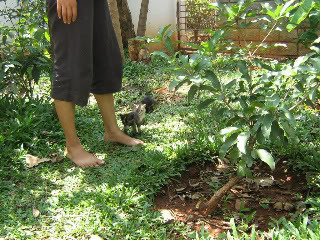
And we actually seem to be altering her perception of cats a little bit. Topshe has no maternal instinct, but she does seem to realize that she is not allowed to harm them. By introducing them to her in very brief, low key sessions and talking softly to her all the time, we've made her understand that they part of the family. I still wouldn't trust her with them alone, but we make progress.

It's been great to make friends with cats, I've never known any closely before. These four are such characters! The big black one, Little Jaguar, is calm, self-sufficient and business like. He eats, sleeps and plays without fuss, and is the most comfortable companion. His favourite game is patting leaves! The other black one, Skinny-winny, is the runt of the litter, and the clown. He's always dashing off madly in random directions, and periodically gets frantic with hunger. He'll bite and scratch and fight with the bottle furiously, spraying the milk all over himself and getting more frustrated as it escapes his mouth. Then there's Funnyface the tortoiseshell (aka Whined-and-dined, for reasons that will soon be apparent), who is clingy and wants to be cuddled all the time. She has big, appealing eyes and miaows at you until you pick her up. (According to an article in Wikipedia, this is typical behaviour for a tortoiseshell -- unbelievable!) And Ambuja the tabby is the cutest, the classic kitten with a kittenish face and kittenish ways. She rolls on her back and bats Topshe on the nose with a chubby paw, completely unafraid. I feel like telling her -- be a little scared, you silly billy! Altogether, they are the most adorable and fascinating bunch, of any species I've met!
We'll all miss them terribly when they go. But as we are firm vegetarians and cats are naturally carnivorous, we are probably not compatible. I don't know if this business of fostering baby animals is a good idea -- it's such a wrench each time you have to part with them. But on the other hand, it seems to serve a useful purpose. And I get to spend time with animals, which I love, without too much long term commitment. I just hope the homes they go to will be good to them always.
Published on April 06, 2012 02:00
Read, Write and Left
Blog of a somewhat indiscriminate reader and gauche (in the French sense of course) writer.
- Harini Gopalswami Srinivasan's profile
- 71 followers


